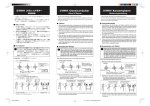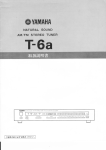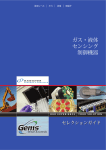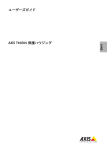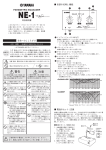Download Yamaha L Series Owner's Manual
Transcript
ACOUSTIC GUITARS WH37180 L_minibook_C_WH37180.pm65 Page 2-3 Printed in China 07.1.15, 9:11 PM Adobe PageMaker 6.5J/PPC Introducing the All New L Series Introducing the All New L Series 25 年目の 変革・New L シリーズ 登場! As it passes the quarter century mark, the L-Series ミュージックシーンにその名を刻んできたヤマハ “L” シリーズが、25年 undergoes a major revision resulting in 16 all new を経てフルモデルチェンジ。新たな世代を担う16モデルの登場です。 models. In redesigning the series, our master 細部に至るまで徹底的にリファインされた、New“L” シリーズは、 ライ craftsmen have produced instruments that deliver トゲージをセットしても存在感のある低音が得られる、弾き応えのある robust low-end response even when using light gauge ギターです。優れた演奏性、丁寧な仕上げ、磨き上げられた “L” シリー strings. Excellent playability, outstanding quality and ズサウンド。音楽とギターを愛するあなたに、 きっとご満足いただける a their unique Yamaha sound are sure to satisfy all. ことと思います。 1 L_minibook_C_WH37180.pm65 2 Page 4-5 07.1.15, 9:11 PM Adobe PageMaker 6.5J/PPC New Bracing Designs Bridge All L-series guitars benefit from a new non-scalloped bracing design that delivers tone that is thick and well focused. The #36 and #26 model instruments feature a square bracing design which utilizes side braces to connect the top brace with its opposite brace on the back. This arrangement transmits string resonance to the back much quicker, causing the entire instrument to come alive with bass response, which the player feels as well. The bridges on all new L-Series guitars offer more overall mass than their predecessors t o d e l i ve r gr e a t e r t o n e f r o m t h e s e instruments. Their designs feature smooth lines and edges to keep the playing surface unencumbered. 新デザインブレイシング ブリッジ 全“L”シリーズに、新デザインのノンスキャロップ・ ブレイシング構造を採用。太くハリのあるサウンドが 特徴です。また、#36/#26モデルでは、 スクエア・ブ レイシング構造を採用。表板と裏板のブレイスをつ なぐサイドブレイスを追加することで、弦振動をより 速くより確実に裏板に伝え、優れたレスポンスと力 強い響きを生み出します。 従来のモデルよりも大きく、重量のあるブリッジを採 用。弦の振動を確実に拾い、表現力豊かなサウン ドを引き出します。また、面取りが施された滑らかな エッジが、 スムーズな演奏を可能にします。 Square Bracing (スクエア・ブレイシング) The vintage style brass tuners found on all #26 model guitars present these instruments with a classic look. Body Selection Whether you prefer a full-sized LL dreadnought, small-sized LS body, auditoriumsized LJ, or versatile LX acoustic-electric, the choice is yours. Each of these body styles is represented in each class letting you choose the instrument that meets your requirements for sound, style, and affordability. 3タイプのボディサイズ Tuners LL LS ボディはドレッドノートスタイルのフル サイズ LL 、スモールサイズの LS 、 オーディ トリアムサイズのLJの3タイ プをラインナップ。サウンド、 スタイル、 ご予算に合わせてお好みのモデルを お探しください。 LJ 糸巻(ペグ) #26モデルにはビンテージの香り漂うブラス製ペグ を採用。 Multilayered Reinforced Neck The five-piece necks on the #36 and #26 models are carved from a single laminated block that features two layers of padauk—an extremely hard wood used for marimba tone bars—sandwiched between three layers of mahogany. Using a mixture of woods in this manner creates a neck that is exceptionally strong and stable. The #16 and #6 model instruments utilize similar 3-ply design of rosewood between two layers of mahogany. 積層強化ネック Cutaway Body Venetian cutaways offer access to the upper frets while adding beauty to these fine instruments. カッタウェイ 美しいカーブを描くベネチアンカッタウェイは、 ハイポジション でのプレイを容易にします。 #36/#26モデルは、 マリンバの音 板にも使われる硬材パドックとマ ホガニーによる5 層構造ネック。 #16/#6モデルは、 ローズウッドを マホガニーで挟んだ3層構造ネッ ク。強度と安定性に優れ、 ソリや ねじれにも強いので、安定したネッ クコンディションを保ちます。 5 ply 3 ply (5 層) (3 層) 3 L_minibook_C_WH37180.pm65 4 Page 6-7 07.1.15, 9:11 PM Adobe PageMaker 6.5J/PPC Caring For Your Yamaha Guitar ヤマハギターを永くご愛用頂くために Wood is a living material, and this fine acoustic instrument, being made from wood, will naturally react to changes in humidity, by contracting and expanding. For this reason, humidification is a very important issue in caring for your guitar. When making guitars we pay very close attention to the wood’s moisture content, carefully managing it throughout the entire manufacturing process. After purchasing the wood, we allow it to dry naturally until its moisture content reaches 12% to 13%. The wood is then moved into a seasoning room where further drying brings the moisture content down to a level somewhere between 6% and 8%. From this point we start manufacture of the instrument, and maintain moisture content at 8% until the instrument is complete, to keep the wood stable all through production. So, after creating an instrument in optimum conditions such as these, we ask that you, the owner of this fine instrument, consider the environment in which you keep your guitar and provide it with adequate humidification. When the guitar is not being used, keep it in its hard case, and store it in a location that varies little in temperature, has a low humidity level, and is not exposed to direct sunlight. Optimum humidity in the room should be between 40% and 50%. In areas or seasons in which humidity is low, we recommend that a humidifier be used to control the humidity. If you do choose to use a humidifier for this reason, please control the humidity level carefully. Sudden variations in temperature or humidity can cause irreparable damage to the guitar. Never leave the guitar in an automobile for a long period of time, likewise never leave the instrument in the car trunk. And when traveling by air we recommend that the instrument be carried onto the plane rather than checking it in as baggage at the counter. Taking the time to follow the advice given above will extend the life and ensure the quality of your guitar. 自然の木を材料とするアコースティック楽器にとって、湿度管理は最も重要な項目です。 加工後も木は生きていますから、湿度の変化により、膨張したり縮んだりします。 このため、 ギターの製作工程においては、木材の含水率(木材が含む水分の比率)は徹 底的に管理されます。購入した木材は含水率12∼13%になるまで充分に天然乾燥され た後、 シーズニングルームにてさらに含水率6∼8%にまで強制乾燥されます。その後の 製作工程では完成まで常に含水率8%を基準に管理され、木材が安定した状態を保ち ながら製作が進められます。 こうして最高のコンディションに調整されたギターをより良い状態で使い続けて頂くため には、 お客様のお手元においても湿度管理に充分お気遣いください。 ギターを使用しない場合は、必ずハードケースに入れ、温度変化が少なく、湿度が低く、 直射日光が当たらない場所に保管してください。室内の湿度は40∼50%が最適です。 湿度が低い地域や季節には加湿器の使用をお薦めしますが、 その際は湿度調整にお気 を付けください。 急激な温度変化と湿度変化は、 ギターに致命的なダメージを与えかねません。車の中に 長時間放置したり、 トランクに入れたままにすることは絶対に避けてください。また、飛行 機での移動の際は、可能な限りカウンターに預けず、機内へのお持ち込みください。 以上のようなことにご注意いただき、 よいコンディションで長く演奏をお楽しみください。 * Please be forewarned. You may notice a white, powder-like substance in the finish on the instrument’s rosewood sides or back. This is lime found naturally in the wood’s grain (from the soil in which the tree grew) and it will not have any effect on the instrument’s sound or quality. ラッカーは塗膜が薄く柔らかいため、 ギター等の楽器には最適な塗料として使われてい ます。しかしその反面、高温多湿の環境に弱く、 また接触により塗膜表面が侵されること があります。末永くギターを美しく、 また弾きやすい状態に保つために、次の事柄にお気 を付けください。 Caring for your guitar’s lacquer finish (#36 models) 1 ゴム等を使用しているギタースタンドにギターを直接のせないでください。塗装面が侵される The lacquer coating is thin and delicate making it an optimum finish for fine instruments such as this guitar. However, the finish is susceptible to changes in temperature, humidity, and the handling of the instrument. To keep your guitar both looking and sounding beautiful for as long as possible, please pay close attention to the following points. ※ ローズウッド類の側板や裏板で、 まれに塗装内に白い粉状のものがみえることがあります。こ れは材の導管内に残った石灰質(育った土壌に含まれたもの)が出てきたものですので、音 や品質に影響するものではありません。あらかじめご了承ください。 ラッカー塗装ギターの取り扱いについて (#36 モデル) ことがあります。ギター本体(胴・ネック) とスタンドの接触部分に布等を当ててのせてくださ い。 2 ハードケースに入れて保管する時は、必ず乾燥剤(シリカゲル) をケース内に入れ、直射日光 の当たらないところに保管してください。またハードケースにしまったまま、長時間保管を続け ることはよくありません。時々開けて換気をしてください。 1 Do not place the guitar directly onto the rubber cushions often found on guitar stands, etc. Such contact can damage the lacquered surface. If such a stand is used, place some cloth over the rubber cushions to prevent contact between the rubber and guitar’s surface. 2 When storing the instrument in its hard case, place a few packets of silica gel inside the case and store the case in a location where it will not be exposed to direct sunlight. Also, storing the instrument in the hard case for long periods of time is not advised. Open up the case occasionally to let the air circulate through the case. 5 L_minibook_C_WH37180.pm65 6 Page 8-9 07.1.15, 9:11 PM Adobe PageMaker 6.5J/PPC TUNING MACHINE TENSION ADJUSTMENT The tuning machines have spring-loaded mechanisms which automatically take up wear, preventing backlash. However, it is possible to adjust the amount of pressure required to turn the machines. Each machine has a tension adjustment screw, as illustrated. 糸巻トルクの調整 糸巻の回転トルクは、下図のトルク調整ネジ q で調節します。 q • Clockwise screw rotation Tighten Loosen tightens the machine. The tuning machines should be adjusted to the extent that they are firm, but can turn smoothly. This adjustment is normally unnecessary, and excessive tightening can lead to premature tuning machine wear. しまる ゆるむ • トルクが弱く、演奏中にチューニングが下がってくる場合 →調整ネジqを右に回す • トルクが強く、チューニングがスムーズに行えない場合 →調整ネジqを左に回す TRUSS ROD ADJUSTMENT トラスロッドの調整 The curvature of the neck should be slightly concave. Clockwise rotation of the nut tightens the rod and corrects for too much concave bow. Counterclockwise rotation of the nut loosens the rod and corrects for too much convex bend. Make any adjustments gradually. Allow five to ten minutes for setting, and check the curvature after each 1/2 turn of the truss rod nut. ヤマハギターはすべて、出荷前に調整をしてからお届けしていますが、 環境の変化等 によりネックの状態が変化する場合があります。 ご使用の前に確認・調整なさると万 全です。トラスロッドのナットを回して、ネックの反りを調整します。 If too much convex bend If too much concave bow 逆反り状態 の場合 If too much convex bend 大きな順反り 状態の場合 If too much concave bow 逆反り状態 の場合 大きな順反り 状態の場合 concave 順反り convex 逆反り NOTE: Unless you have experience with truss rods, we suggest that you entrust this adjustment to your dealer. 注意:トラスロッドの調整方法がわからない場合は、 お買い求めのお店へお申し出ください。 7 L_minibook_C_WH37180.pm65 8 Page 10-11 07.1.15, 9:11 PM Adobe PageMaker 6.5J/PPC このたびは、ヤマハギターをお買い求めいただきまして、 まことにありがとうございます。 優れた性能を充分に発揮させると共に、 いつまでも支障なくお使いいただくため、 ご使用 の前にこの取扱説明書をよくお読みになってください。以下の「安全へのこころがけ」に は、思わぬけがや事故を未然に防ぐための注意が書かれています。内容をご理解の上、 この製品を正しく安全にお使いいただきますようお願いいたします。 注意 安全へのこころがけ ヤマハギターを安全にご利用いただくための注意 電気による事故を防ぐために ● 悪天候の屋外や、 湿気が特に多い場所で使用する場合は注意が必要です。 接続する ギターアンプなど外部機器の取扱説明書もよくお読みください。 > 落雷による事故、火災や感電の原因となることがあります。 保管は適切な場所で ● 火気の近くをさけ、 安定した低い場所に保管してください。 > 火災の原因となったり、地震の際に落下してけがの原因となることがあります。 思わぬけがをしないために ● ストラップを使用して演奏する場合 は、 ストラップがギターに確実に固定 されていることを確認してください。 ● 楽器を振りまわすなどの乱暴な取り 扱いはしないでください。 > 楽器がストラップからはずれて落下した り、周囲の人を傷つけるなど、思わぬ事 故の原因となります。 ● 弦を交換するときや調整するとき ● お子様の手の届く所には、 立て掛けないでください。 > お子様が触れると、倒れてけがをする可能性があります。 は、顔を楽器に近づけすぎないよう にしてください。 > 不意に弦が切れて目 を傷つけるなど、思わ ぬけがの原因となる ことがあります。 ● 弦を交換したあと、 弦の不要な部分 は短く切りそろえてください。 > 弦の先は鋭利なため、けがの原因と なることがあります。 ● 楽器のお手入れは、 柔らかい布で乾 拭きしてください。 その際、 弦の先端 部分でけがをしないように注意して ください。 乾電池の使用は正しく ● 乾電池を使用するギターは、 指定された型の乾電池を表示された極性 (プラスとマ イナスの方向)に合わせて正しくはめこんでください。 ● 2本以上の乾電池を使用するギターには、 新しい乾電池と古い乾電池とを混ぜて使 用しないでください。 > 誤った使い方は、乾電池の破裂や液漏れを引き起こし、 けがや汚損の原因となります。 その他、取り扱い上の注意 ● この製品は工場出荷の際に最適な状 態に調整されています。調整が必要 なときは、技術を必要とする部分も あるため、なるべくお買い求めのお 店にご相談ください。ご自分で調整 される場合は、この取扱説明書に書 かれた調整方法にしたがって行って ください。 ● 楽器の演奏は適当な音量で行ってくだ さい。 特に深夜の使用は、 他人の迷惑と ならないよう充分注意してください。 ● シールドコードの脱着は、 ギターア ンプの電源を切るか、ギターアンプ のボリュームを絞ってから行ってく ださい。 > ギターアンプの寿命を縮めることがあります。 ● 楽器のお手入れの際は、 柔らかい布 で乾拭きしてください。また、スプ レー式の殺虫剤を近くで散布しない でください。 > 楽器の外装を変質させることがあります。 ● 長時間使用しない場合は乾電池を取 ● 落下や転倒、 輸送時の衝撃によって最 も起こりやすい事故は、 ネック折れで す。ギターを使用しない時は、ケース にしまうかスタンドに立てて、 倒れに くい状態で保管してください。 ● 物をぶつけたり、 落としたりの乱暴 な取り扱いはさけてください。また、 スイッチやコントロールツマミなど に無理な力を加えないでください。 > 故障の原因となることがあります。 り外し、次のような場所をさけて保 管してください。 ・直射日光の当たる場所 ・温度が特に高い場所、 または特に低い場所 ・湿度が特に高い場所、 ホコリや振動の多い場所 ● 夏期の自動車の室内は非常に高温と なります。 楽器を車内に放置しないで ください。 ● 使用後の乾電池は火中に捨てないでください。 一般のゴミとは分けて、定められた場所に捨てましょう。 9 L_minibook_C_WH37180.pm65 10 Page 12-13 07.1.15, 9:11 PM Adobe PageMaker 6.5J/PPC Thank you for purchasing this Yamaha Guitar. To get the most out of this fine instrument, and to use it in a safe manner, we urge you to read this Owner’s Manual before using the instrument. The cautions given in the following Safety Precautions section are provided to prevent unexpected injuries or accidents. Please understand each of the cautions and use the instrument in a safe and proper manner. Caution Safety Precautions Using your Yamaha Guitar in a Safe Manner Preventing Electrical Accidents • If the instrument must be used outdoors in bad weather, or in a place with high humidity, please use caution. Please read the Owner’s Manuals that came with the devices, such as power amplifiers, etc., that you connect your guitar to. > Accidents such as fire or electric shock can occur due to lightning strikes. Store the Instrument Properly • Do not keep the instrument close to a fire or flame, and keep it on a low, > Preventing Unexpected Injuries and Accidents • When using a strap, make sure the • Do not place your face close to the instrument when changing or adjusting the strings. strap is securely attached to the guitar. • Do not treat the instrument in a rough manner such as swinging it about, etc. > > The strap on the guitar may detach causing unexpected accidents such as the instrument dropping, etc., or injuring persons close by. Str ings may suddenly break causing injuries to eyes, etc. It can be the cause other unexpected injuries as well. • After changing the strings, cut off > the leftover string ends. String ends are sharp and can cause injuries. • Clean the instrument with a soft, dry cloth. And when cleaning the headstock, be careful not to injure yourself on the sharp string ends. Using Batteries Properly • For guitars that use a battery, make sure that only the specified battery is used and it is installed with its polarity markings aligned properly. • On guitars that require two or more batteries, do not mix new batteries with old. > Improper use of batteries can result in the batteries rupturing or leaking, causing injury or damage. • Never incinerate batteries. > Separate batteries from household garbage and dispose of them in a proper manner. stable surface. The instrument can catch fire, and earthquakes can cause it to fall if stored in a high location. • Do not leave the instrument leaning against the wall, etc., in the vicinity of > children. The instrument may be bumped causing it to fall over resulting in injury. • The Be Careful When Handling and Other Cautions • When connecting or disconnecting guitar has been properly adjusted before being shipped from the factory. In the event adjustment is necessary, contact the dealer from whom you purchased the instrument, if possible, as special skills may be required. For those adjustments that can be performed by the owner, please closely follow the instructions given in the Owner’s Manual for the procedure. • When playing the instrument, pay attention to the volume level. Especially late at night, take neighbors and those who are close by into consideration. the cable, make sure the guitar amplifier’s power is switched OFF, or the amplifier’s volume is turned all the way down. > Not doing so can shorten the life of the guitar amplifier. • When cleaning the instrument, use a soft, dry cloth. Also, do not spray insecticides close to the instrument. > Doing so can damage the guitar’s finish. • If the instrument is not going to be used for an extended period of time, remove the batteries and keep the instrument in a place other than those listed below. • Broken guitar necks are mostly the result of accidents such as dropping the guitar, the guitar falling over, or from shocks occurred during transport. When the guitar is not being used, make sure it is kept on a sturdy stand where it won’t fall over, or place it in its case. • Do not treat the instrument in a rough manner like throwing objects at the instrument, dropping the instrument, etc. And do not put excessive force on the switches or control knobs, etc. > Doing so can result in damage. • Locations subject to direct sunlight. Locations subject to extremely high or low temperatures. • Locations subject to high humidity, dust, or vibration. • • Dur ing the summer season, temperatures inside of a car can become extremely hot. Do not leave the instrument inside of a car. 11 L_minibook_C_WH37180.pm65 12 Page 14-15 07.1.15, 9:11 PM Adobe PageMaker 6.5J/PPC
This document in other languages
- 日本語: Yamaha L series







